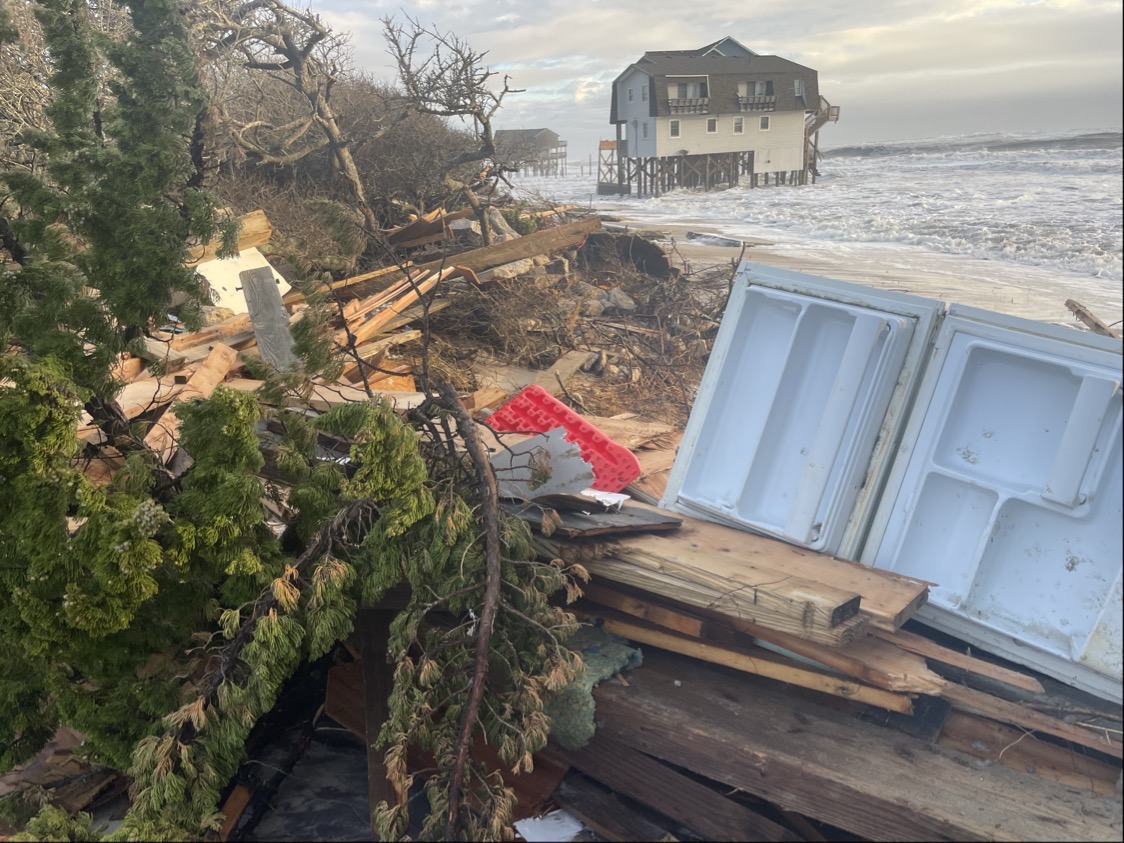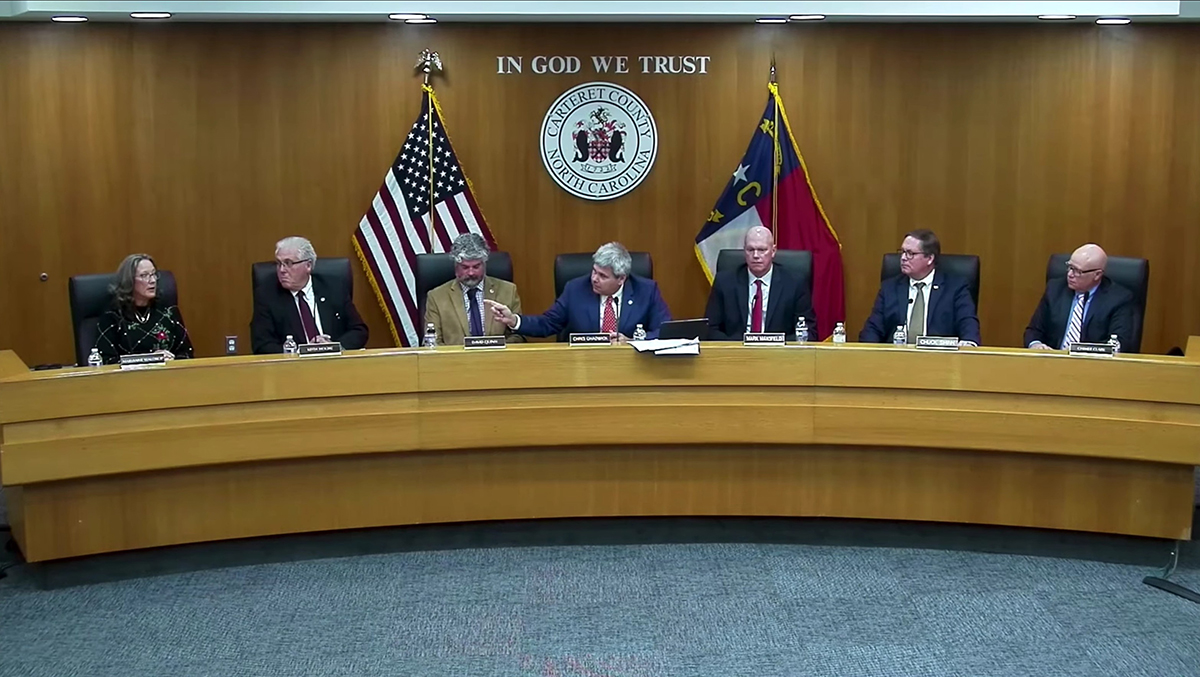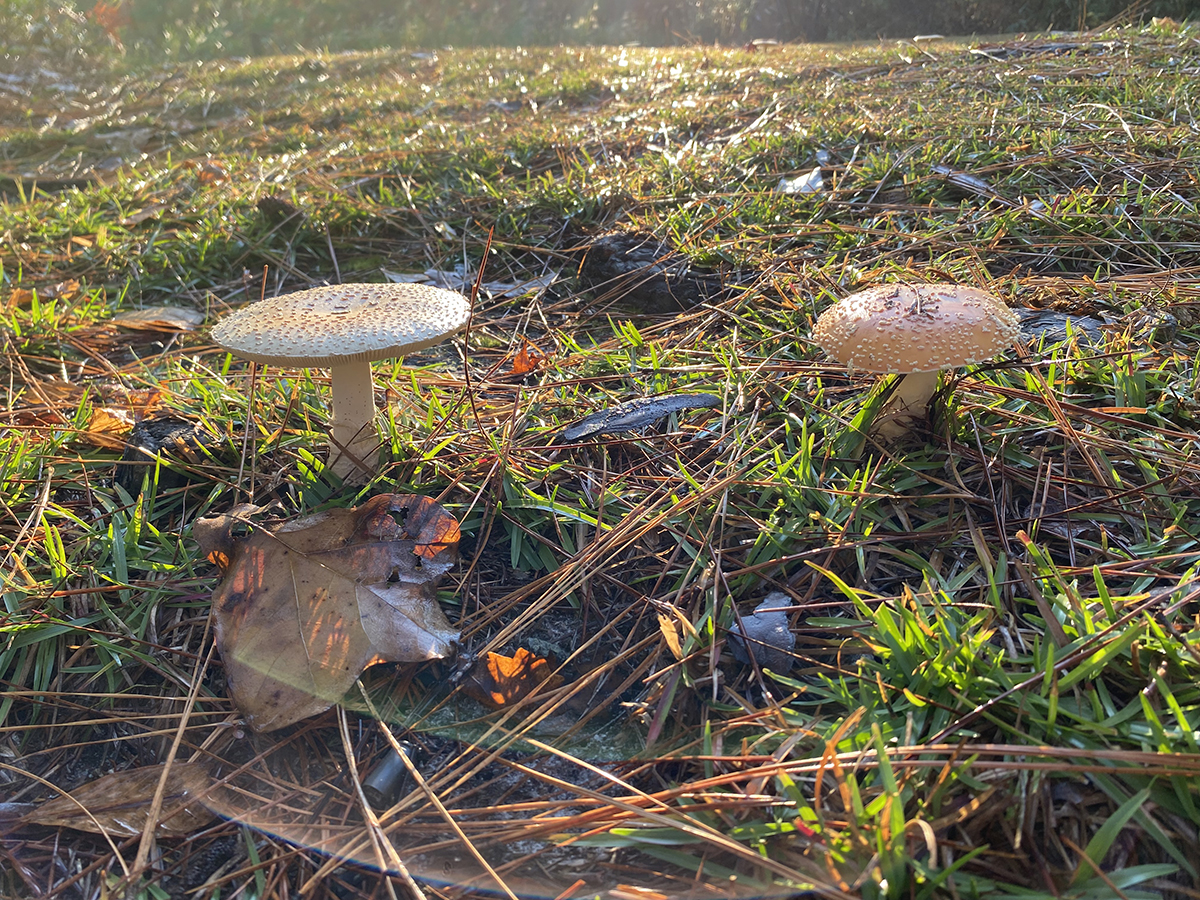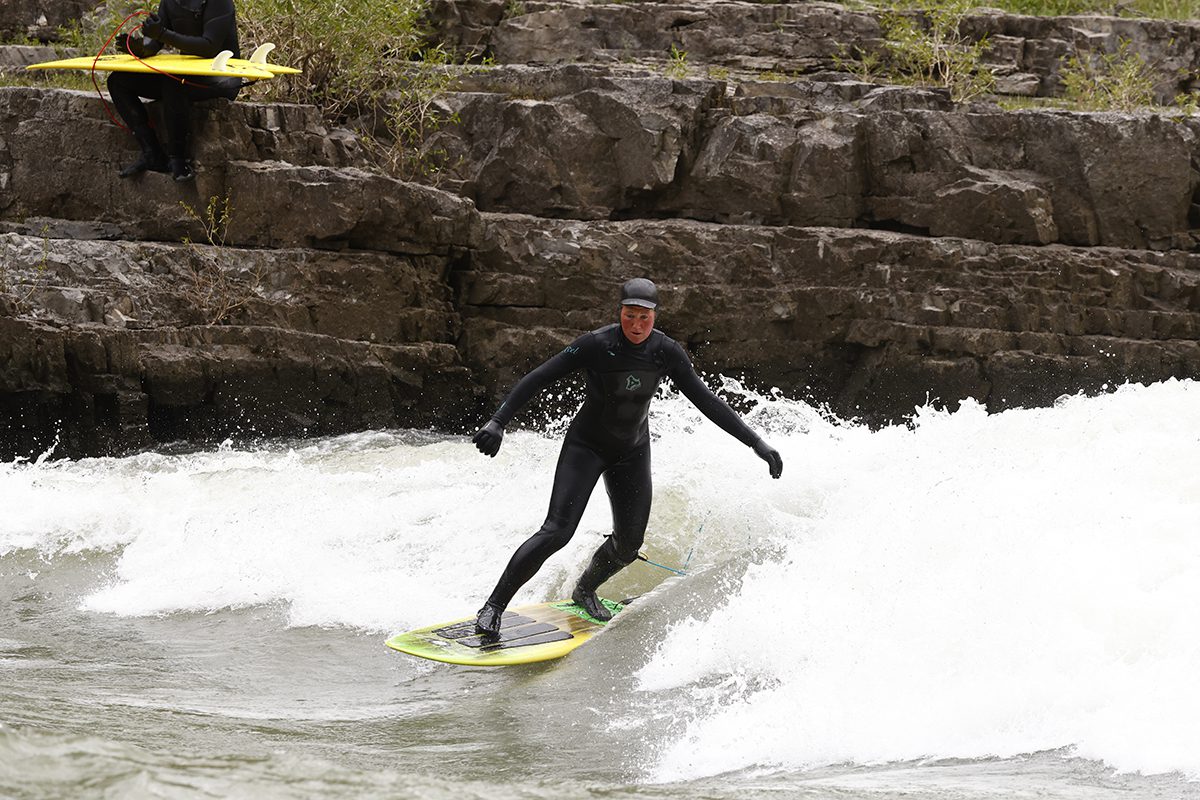
Editor’s Note: After Sam Bland retired from his position as superintendent at Hammocks Beach State Park, he joined the staff of the North Carolina Coastal Federation. During his time as a coastal specialist in the 2010s, he would periodically write about his time in the field for Coastal Review. Now traveling the country, Bland drops a line every once in a while to share a new adventure with his readers, such as the following:
In northwestern Wyoming, just south of the town of Jackson, a 20-mile stretch of road makes its way through the mountains down to the town of Alpine.
Supporter Spotlight

It’s a gorgeous drive any time of year with towering mountain hills covered in pine, fir, cottonwood and aspen trees. Identified as the Snake River Canyon, Grand Canyon of the Snake or Alpine Canyon, the river slithers right beside the road.
The upper part of the river runs slow enough in the canyon that beavers dam off braids of the river, forming placid ponds and wetlands beneficial to all wildlife. Gradually, the grade of the river begins to drop and the velocity of the water picks up the pace.
During our travels out west into Wyoming, Idaho and Utah, my wife, Bright, and I have driven this road many times.
We look for the beavers and otters swimming in the ponds, the moose in the willows, elk in the meadows and mountain goats high on the steep cliffs. Much of the landscape on both sides of the road are public lands, part of the Bridger-Teton National Forest.
Every few miles, there are access areas for hiking, camping, fishing and picnicking. One access area sign caught our eye, but we would always drive past. The sign simply stated, “Lunch Counter” with the word “Kahuna” underneath it.
Supporter Spotlight
The use of the word “kahuna” on a national forest sign in Wyoming was quite intriguing. A Hawaiian word, kahuna is used to signify a professional expert, such as a doctor.
During my years of surfing the North Carolina coast, I would occasionally hear the word being called out as a big swell began to roll in. In late spring, fascinated by the sign, we drove down to the Lunch Counter to see what was cooking.
Arriving in the parking lot, we saw a man in a full wetsuit with a surfboard tucked under his arm disappear down a wooded trail towards the river. Wait, what? This looked so out of place in cowboy country. We dashed down the trail, and from an overlook we could see the Class III rapids of the Snake River.
The serene beaver pond waters of the upper river were now a raging whitewater serpent. In the mist of the aquatic chaos was a lone surfer riding the face of a large, standing wave. We now understood, the Lunch Counter and Kahuna referred to the rapids.
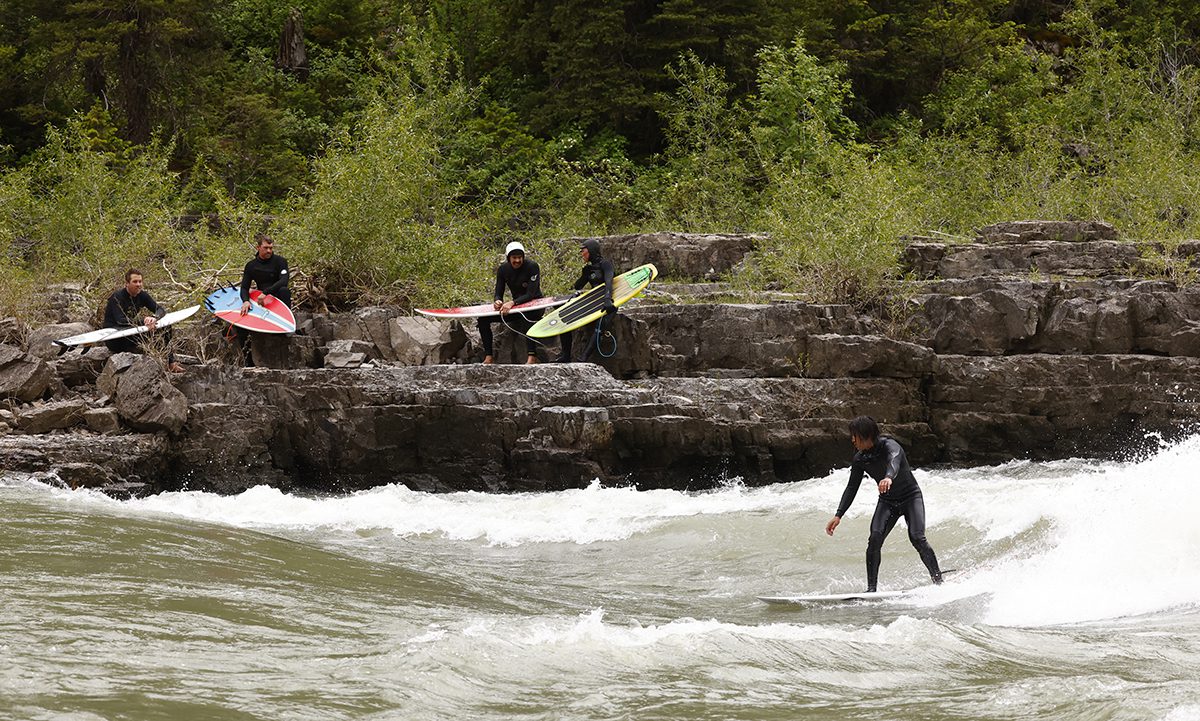
The Snake River Canyon was formed millions of years ago with tectonic plates butting heads, creating thrust-fold belts along with glacial gouging and erosion by the river itself.
At some point, geologic forces created a flat shelf with a large boulder lodged against it in the riverbed. Perhaps a massive flood rolled the boulder into just the right place. Prior to reaching the Kahuna and Lunch Counter rapids, the width of the river narrows with small granite walls on each side. It is here that the water shoots through like a firehose against the rocks creating the standing wave.
The wave is seasonal though, peaking in late spring and early summer due to melting snowpack. North of the Snake River Canyon, the flow is controlled by the Jackson Lake dam in Grand Teton National Park.
In early spring, the gates of the dam are cracked open to keep downstream reservoirs topped off for agricultural irrigation. Snowmelt from streams and creeks below the dam spills into the Snake River, causing the river to gush a high flow rate of 14,000 cubic feet per second.
Water flowing over the Lunch Counter at 7,000 to 13,000 cubic feet per second creates a wave tempting enough to lure a surfer into the maelstrom. Dam control, snowpack and daily temperatures dictate when and for how long this river surfbreak will last.
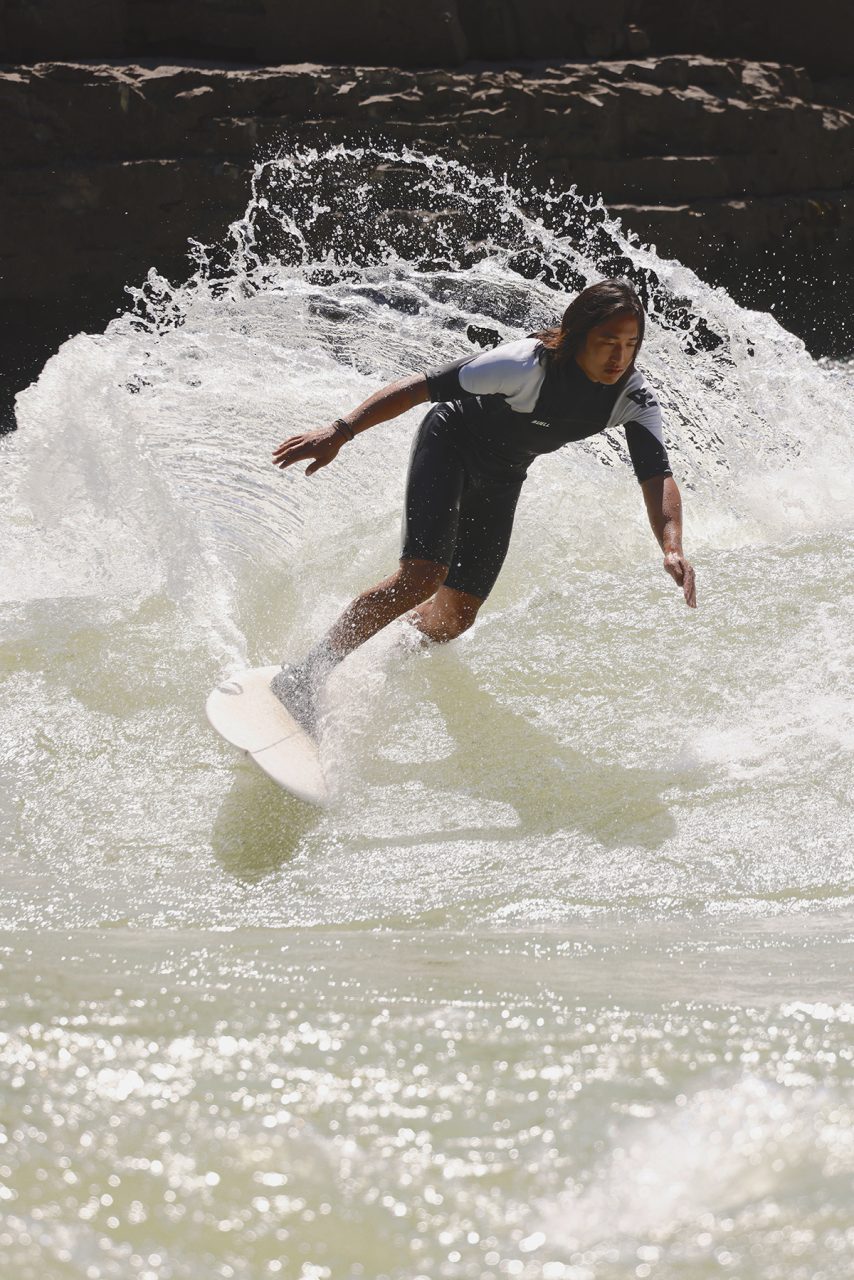
The flow can be variable. Thus, the wave may last for a month, a few days or not at all.
The Lunch Counter was first named in the 1960s by David Hansen, a local whitewater rafting guide. Out on his raft, with the undulating walls of waves looming ahead, he has been quoted as saying “if we are going to eat our lunch, it’s going to be right here.” The unique quote has become the identity of the Lunch Counter ever since.
It wasn’t until 1978 when a trio of brave whitewater rafting guides eyed the wave with envy, scrounged up a surfboard without an ocean in sight, and gave it a try. Surfing on the Snake was born. Like a siren, the wave continues to taunt, tempt and seduce surfers today.
Bright and I made our way down the worn gravel trail to a water-smoothed granite shelf along the river. Almost a dozen wetsuit-clad surfers were scattered about. Adorned with booties, gloves and a 5/4mm taped wetsuit, they were protected from the frigid 40- to 50-degree snowmelt.
One surfer was on the wave while another was drifting downstream after being bucked off the watery horse. Six surfers were sitting in a lineup on a rocky bench waiting for their turn on the curl as if kids patiently waiting for the music of an ice cream truck.
Watching the surfers, the first thing that hit me was that the power of the water is coming at you, not from behind like an ocean wave. What an adjustment for the mind and body for an ocean surfer.
Just to get to the wave was an endeavor in itself. First, you must jump off a rocky cliff with the surfboard underneath you, landing into a lower trough of water created by the uneven stream bottom. This trough, what the surfers called “the seam,” would then drift them into position below the standing wave.
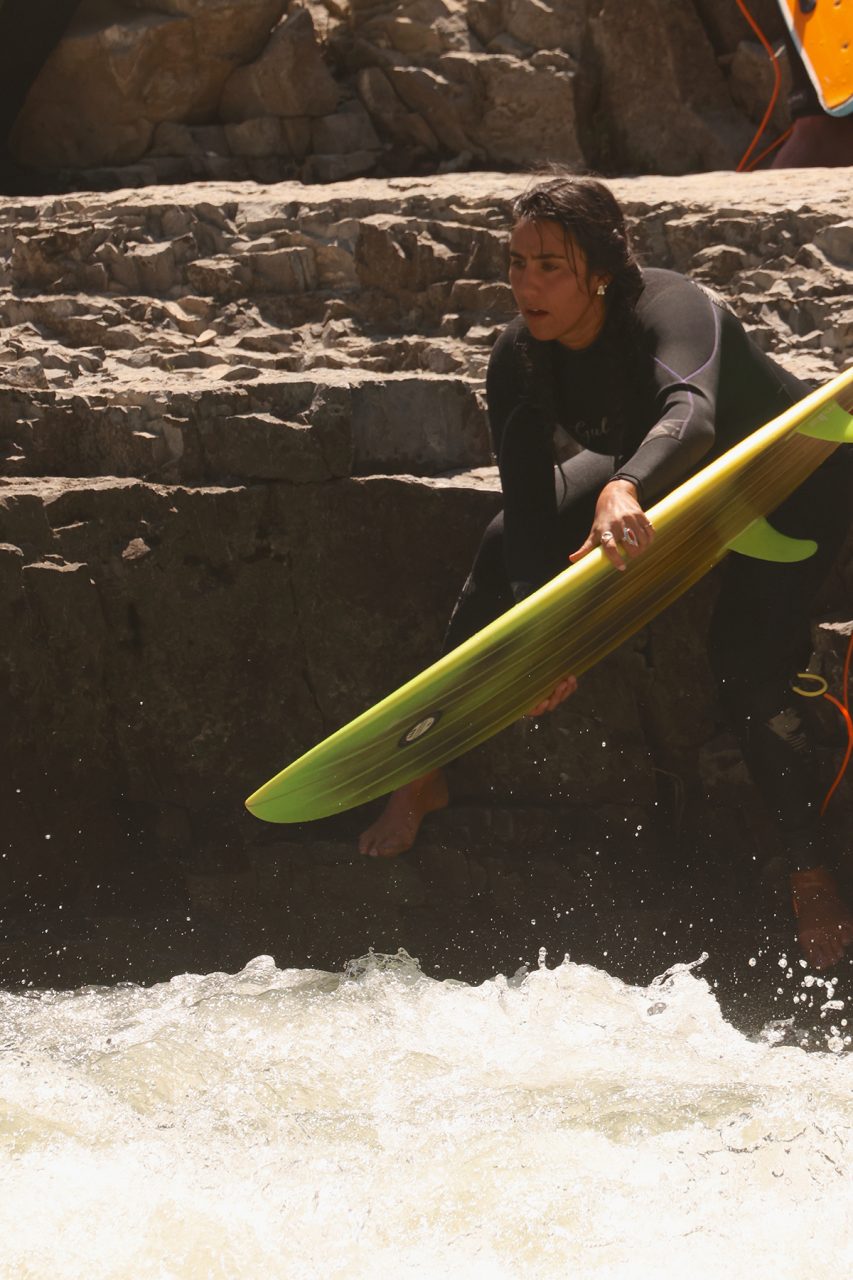
Here, the current would pull them up and into the wave. Paddle, paddle, paddle in the whiteout of foamy madness before you are chewed up and spit out. Most of the surfers would quickly find the sweet spot at the base of the wave where they would lay on the board, adjusting their balance to keep the board forward on the wave. Then they would pop up, and if the surf gods are willing, ride a river wave.
Some surfers would just chill in the pocket of the wave, occasionally drifting up the face and back down. Off to the right of the wave, the pulsing waters would create a bit of a swell that allowed some surfers to drift to the right with a quick rip to the left, fanning the water up like a rooster tail.
Unlike ocean waves, some of these rides lasted for minutes. The more experienced riders would, at times, voluntarily bail on the wave, granting others a chance to catch the Snake. But more often than not, surfers were victims of a cold face-plant due to wandering concentration. Wipe out here and you are treated to another ride, rag-dolling down the rapids and tossed like a salad.
Here, the surfers are on high alert, keeping an eye out for hazards such as a tree branch hurling toward them like a water javelin. They also have to share the break with the hundreds of kayakers and rafting boats charging into the wave seeking their own thrill.
Whitewater kayakers in their short, stubby boats would back into the wave as well. Paddling to stay in the curl, they would dance on the wave, spinning circles much to the delight of the cheering surfers. A train of rafts might come along, aiming straight for wave.
Like a powerful bronco, the wave would try to throw them out of the boat under a shower of cold river rain.
We watched about a dozen surfers of various skill levels ride the standing wave. A few were still learning this break, but, for the most part, all the riders were solid.
One in particular, Amanda Studdard, originally of Portland, Oregon, was one with the wave.
Studdard’s movements on the wave were smooth and sure, taming the current surging under her board. She was calm and at peace on the wave while the chaos off the river surrounded her — a true soul surfer. At times, she would break away from the Zen of it all. Drifting higher and to her right on the wave, she would then make a slashing left turn gouging the wave with her stick. A wall of spray in her wake added to the watery mayhem.
A lover of river surfing, Studdard was on her lunchbreak, sneaking in a few rides. An appropriate thing to do while at the Lunch Counter. She has been hooked on river surfing ever since she dropped in on a wave at a human-made break in a waterpark in Bend, Oregon. Her occupation allows her flexibility to work remotely and drift down to the Lunch Counter each year — an idyllic life shared with her two dogs Loki and Laska along with her playful kitten, Violet. Her feel and connection with the wave were obvious, what she describes simply as “magical.”
Studdard was joined by her friend, Natalie Catania. After tasting the wave four years ago, she has returned each spring to get her fill. Catania, without hesitation, leaps off the bank, drifts the seam perfectly into the face of the wave and springs onto the deck of the board, making it look so easy. After learning to surf on river waves, she prefers them to ocean swells. Even her board is designed for river surfing.
She explained that with the evolution of river surfing, board shapers are now designing specifically for the river waves. An ocean board will do, but a board carved to meet the distinctive aspects of the river will provide better performance. Freshwater is less buoyant than saltwater, thus, a river board needs to be thicker to provide better lift. They are also wider and shorter, 4.5 to 6 feet in length. Different river waves might also require a uniquely shaped board, resulting in a surfer having a number of boards in their quiver.
Having ridden a number of other river waves, the Lunch Counter always coaxes Catania back to Wyoming. “It’s a raw experience,” she said. “Even though it is intense, you find a state of bliss.”
When I think of some of the famous surf breaks, places like Mavericks, Pe’ahi (Jaws), Banzai Pipeline, Teahupo’o, and Nazare come to mind. Now, I will need to add the Lunch Counter to the list.
River surfing is gaining popularity throughout the world with breaks in Germany, Austria, Norway, New Zealand and Canada. The Lunch Counter is thought to be one of, if not the, best natural river surf break in the United States.
Surfer Today has listed it as one of the best river surfing waves in the world. American Surf Magazine has it on the top of their list of best river surfing destinations in the U.S.
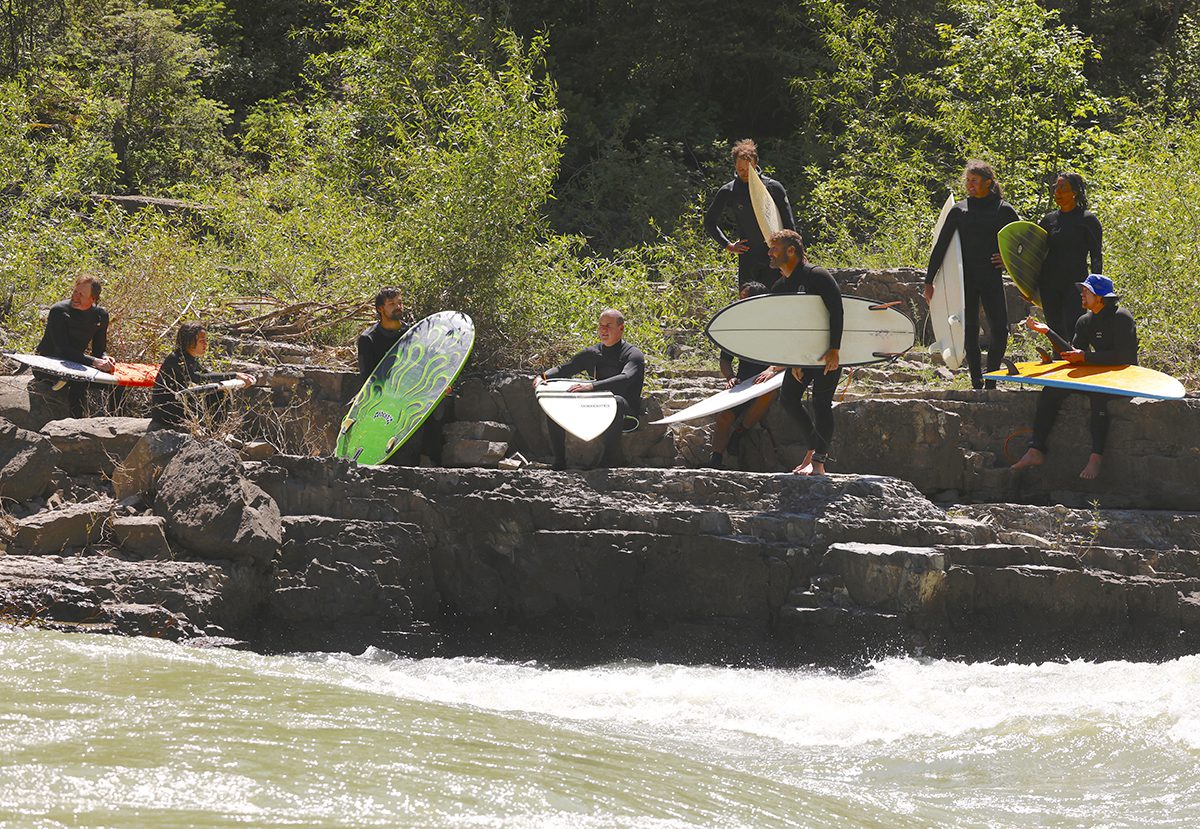
You would think with such a heady reputation that the surfers would be territorial. Quite the contrary. The vibe is peaceful, welcoming, encouraging and supportive. Compared to ocean lineups where I have seen punches thrown, this was a breath of fresh mountain air. Even the few youngsters who were cutting their teeth on this river wave were given the same respect and opportunity as the adults. And these grommets could shred.
While the melting of the snowpack diminishes and the gates of the reservoir dams are cranked down, the wave will subside as if a low tide. By mid-July, the wave will retreat into the riverbed, hibernating, waiting to roar again next spring.
As the wave-creating snow blankets the mountains this coming winter, the surfers will grow hungry — hungry with an appetite that can only be satisfied by a seasonal special found only at the Lunch Counter.



